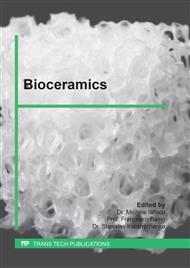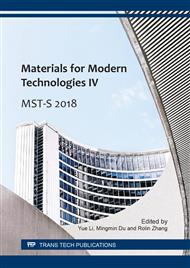[1]
C.Perka, O.Schultz, R.S. Spitzer, K.Lindenhayn, G.R. Burmester, M.Sittinger, Segmental bone repair by tissue-engineered periosteal cell transplants with bioresorbable fleece and fibrin scaffolds in rabbits, Biomaterials .21(2000) 1145-1153.
DOI: 10.1016/s0142-9612(99)00280-x
Google Scholar
[2]
H.Komaki, T.Tanaka, M.Chazono, T.Kikuchi, Repair of segmental bone defects and fibroblast growth factor-2, Biomaterials. 27(2006) 5118-5126.
DOI: 10.1016/j.biomaterials.2006.05.031
Google Scholar
[3]
Z.Gugala, S.Gogolewski, Healing of critical-size segmental bone defects in the sheep tibiae using bioresorbable polylactide membranes, Injury. 33(2002) 71-76.
DOI: 10.1016/s0020-1383(02)00135-3
Google Scholar
[4]
S.Bose, M.Roy, A.Bandyopadhyay, Recent advances in bone tissue engineering scaffolds, Trends Biotechnol. 30(2012) 546-554.
DOI: 10.1016/j.tibtech.2012.07.005
Google Scholar
[5]
D.W. Hutmacher, Scaffolds in tissue engineering bone and cartilage, Biomaterials.21(2000) 2529-2543.
DOI: 10.1016/s0142-9612(00)00121-6
Google Scholar
[6]
H.H. Horch, R.Sader, C.Pautke, A.Neff, H.Deppe, A.Kolk, Synthetic, pure-phase beta-tricalcium phosphate ceramic granules (Cerasorb®) for bone regeneration in the reconstructive surgery of the jaws, Int.J. Oral Maxillofac. Surg .35(2006) 708-713.
DOI: 10.1016/j.ijom.2006.03.017
Google Scholar
[7]
M.Hoshino, T.Egi, H.Terai, T.Namikawa, K.Takaoka, Repair of long intercalated rib defects using porous beta-tricalcium phosphate cylinders containing recombinant human bone morphogenetic protein-2 in dogs, Biomaterials. 27(2006) 4934-4940.
DOI: 10.1016/j.biomaterials.2006.04.044
Google Scholar
[8]
J.Yuan, L.Cui, W.J. Zhang, W. Liu, Y.L. Cao, Repair of canine mandibularbone defects with bone-marrow stromal cells and porous beta- tricalcium phosphate, Biomaterials. 28(2007) 1005-1013.
DOI: 10.1016/j.biomaterials.2006.10.015
Google Scholar
[9]
T.M. Freyman, I.V. Yannas, L.J. Gibson,Cellular materials as porous scaffolds for tissue engineering, Progress in Materials Science.46(2001) 273-282.
DOI: 10.1016/s0079-6425(00)00018-9
Google Scholar
[10]
P.Kasten, I.Beyen, P. Niemeyer, R.Luginbühl, M.Bohner, W.Richter, Porosity and pore size of [beta]-tricalcium phosphate scaffold can influence protein production and osteogenic differentiation of human mesenchymal stem cells:an in vitro and in vivo study, Acta Biomaterialia.4(2008).
DOI: 10.1016/j.actbio.2008.05.017
Google Scholar
[11]
T.Mygind, M.Stiehler, A.Baatrup , H.Li , X.Zou ,A.Flyvbjerg, M.Kassem, C.Bünger, Mesenchymal stem cell ingrowth and differentiation on coralline hydroxyapatite scaffolds,Biomaterials.28(2007) 1036–1047.
DOI: 10.1016/j.biomaterials.2006.10.003
Google Scholar
[12]
T.D. Roy, J.L. Simon, J.L. Ricci, E.D. Rekow, V.P. Thompson, J.R. Parsons,Performance of degradable composite bone repair products made via three-dimensional fabrication techniques, Journal of Biomedical Materials Research Part A .66A(2003).
DOI: 10.1002/jbm.a.10582
Google Scholar
[13]
J.D. Bobyn, R.M. Pilliar, H.U. Cameron, G.C. Weatherly, The optimum pore size for the fixation of porous-surfaced metal implants by the ingrowth of bone, Clinical Orthopaedics and Related Research .(1980)263–270.
DOI: 10.1097/00003086-198007000-00045
Google Scholar
[14]
H.-Y.Cheung, K.-T.Lau, T.-P.Lu, D.Hui, A critical review on polymer-based bio-engineered materials for scaffold development, Composites Part B: Engineering.38(2007) 291–300.
DOI: 10.1016/j.compositesb.2006.06.014
Google Scholar
[15]
P.S.M.D. Eggli, W.P.D. Moller, R.K.M.D. Schenk, Porous hydroxyapatite and tricalcium phosphate cylinders with two different pore size ranges implanted in the cancellous bone of rabbits: a comparative histomorphometric and histologic study of bony ingrowth and implant substitution, SO—Clinical Orthopaedics & Related Research .232(1988).
DOI: 10.1097/00003086-198807000-00017
Google Scholar
[16]
Y.L. Liu, J.Schoenaers, K.d.Groot, J.R.d.Wijn, E.Schepers, Bone healing in porous implants: a histological and histometrical comparative study on sheep, Journal of Materials Science: Materials in Medicine.11(2000) 711–717.
DOI: 10.1023/a:1008971611885
Google Scholar
[17]
B.Flautre, M.Descamps, C.Delecourt, M.C. Blary, P.Hardouin, Porous HA ceramic for bone replacement:role of the pores and interconnections—experimental study in the rabbit, Journal of Materials Science: Materials in Medicine 12(2001) 679–682.
DOI: 10.1023/a:1011256107282
Google Scholar
[18]
P.Sepulveda, J.G.P. Binner, S.O. Rogero, O.Z. Higa, J.C. Bressiani, Production of porous hydroxyapatite by the gel-casting of foams and cytotoxic evaluation, Journal of Biomedical Materials Research.50(2000) 27–34.
DOI: 10.1002/(sici)1097-4636(200004)50:1<27::aid-jbm5>3.0.co;2-6
Google Scholar
[19]
A.Tampieri, G.Celotti, S.Sprio, A.Delcogliano, S.Franzese, Porosity-graded hydroxyapatite ceramics to replace natural bone, Biomaterials. 22(2001)1365–1370.
DOI: 10.1016/s0142-9612(00)00290-8
Google Scholar
[20]
M.Dehurtevent, L.Robberecht, J-C.Hornezc, A.Thuaultc, E.Deveauxb, P.Béhin, Stereolithography: A new method for processing dental ceramics by additive computer-aided manufacturing, Dental Materials 33(2017) 477-485.
DOI: 10.1016/j.dental.2017.01.018
Google Scholar
[21]
X.Song , Z.Y. Chen , L.W. Lei , K.Shung , Q.F. Zhou ,Y.Chen, Piezoelectric component fabrication using projection-based stereolithography of barium titanate ceramic suspensions, Rapid Prototyping Journal .23(2017) 44-53.
DOI: 10.1108/rpj-11-2015-0162
Google Scholar
[22]
H.Lin, D.N. Zhang, P.G. Alexander, G.Yang, J.Tan, A.W.-M.Cheng, R.S. Tuan, Application of visible light-based projection stereolithography for live cell-scaffold fabrication with designed architecture, Biomaterials .34(2013) 331-339.
DOI: 10.1016/j.biomaterials.2012.09.048
Google Scholar
[23]
R.Felzmann,S.Gruber, G.Mitteramskogler, P.Tesavibul, A.R. Boccacciniet, Lithography-based additive manufacturing of cellular ceramic structures , Advanced Engineering Materials.14(2012) 1052–1058.
DOI: 10.1002/adem.201200010
Google Scholar
[24]
X.Li, D.C.Li, B.H.Lu, Fabrication of bioceramic scaffolds with pre-designed internal architecture by gel casting and indirect stereolithography techniques, J Porous Mater. 15(2008)667-671.
DOI: 10.1007/s10934-007-9148-9
Google Scholar
[25]
C.H. Liu, Preparation and properties of porous scaffolds for calcium phosphate biocerates in bone tissue engineering, Master dissertation, Southeast University, China, (2004).
Google Scholar
[26]
L.Z. Zhu, Biomimetic Interface Design and Fabrication Technique of the Hydrogel/Ceramic Composite Joint Scaffold, Master dissertation, Xi'an Jiaotong University, China, (2012).
Google Scholar




